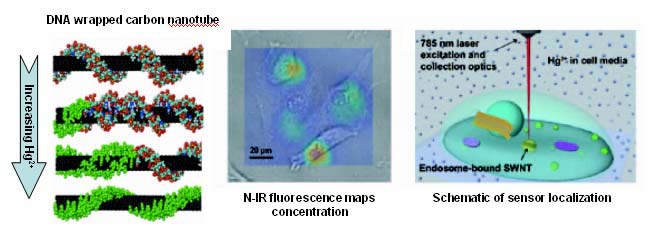New DNA Sandwich Detects Genetic Damage

Human DNA wrapped around fabricated microscopic structures can detect genetic damage and potential disease inside living cells.
Picture a phone cord wrapped around a pencil.
The carbon nanotube and DNA sandwich might one day join a growing list of tiny probes that could be launched into the human body to monitor health.
Nanodevices are constructed with individual molecules.
In the new device, DNA wraps around the nanotube with a certain shape defined by the negative charges along its backbone, researchers explain. When exposed to ions of calcium, mercury, sodium or other targeted substances, the negative charges are neutralized and the DNA changes shape. This causes it to glow, or fluoresce, at different wavelengths of infrared light.
"The nanotube surface acts as the sensor by detecting the shape change of the DNA as it responds to the presence of target ions," said University of Illinois at Urbana-Champaign graduate student Daniel Heller, lead author of a paper on the work in the Jan. 27 issue of the journal Science.
Other nanoscale sensors are under development. One limitation to using them in real-world situations is that the fluorescence is typically blocked by the body's tissue and hard to detect.
Get the world’s most fascinating discoveries delivered straight to your inbox.
"This is the first sensor of its kind that operates in the near infrared region of the light spectrum," said Michael Strano, a professor of chemical and biomolecular engineering at the university. "This light is so red that it passes through many centimeters of human tissue, and therefore, our sensor could be used in cells while inside of the body."
The DNA is like a scaffold, Strano explained, and it can be tailored to respond to a wide range of substances that can indicate potential for disease.
The work has been done in a lab setting on living cells but has not yet been tried inside a person.
"We are focusing now on [applications] that are relevant to disease detection and treatment," Strano told LiveScience. "The technique can also be used to track newly developed drugs as they travel into various types of cells. We are only a year or so away from this type of application."
- Gold Probes Could Reveal Cancer in Your Body
- New Noninvasive Imager Detects Deadly Melanoma Early
- Microbe and Machine Merged to Create First 'Cellborg'
- Cancer Takes Over Top Spot as Killer of Americans Under 85
- High-tech Probes Sneak Inside Your Cells
Robert is an independent health and science journalist and writer based in Phoenix, Arizona. He is a former editor-in-chief of Live Science with over 20 years of experience as a reporter and editor. He has worked on websites such as Space.com and Tom's Guide, and is a contributor on Medium, covering how we age and how to optimize the mind and body through time. He has a journalism degree from Humboldt State University in California.



